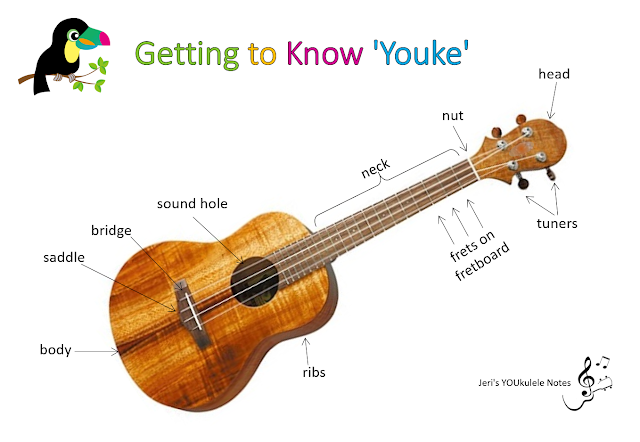 All material on this site is protected by an international Creative Commons Attribution-NonCommercial-NoDerivs 4.0 License.This means that if you use my materials in other than home or classroom settings,
credit must be given for my work. Commercial use is not allowed, and you may not claim any part of this
work as your own nor alter it. My logo/blog URL should be included on copies you make or share: http://youkulelenotes.blogspot.com/.
All material on this site is protected by an international Creative Commons Attribution-NonCommercial-NoDerivs 4.0 License.This means that if you use my materials in other than home or classroom settings,
credit must be given for my work. Commercial use is not allowed, and you may not claim any part of this
work as your own nor alter it. My logo/blog URL should be included on copies you make or share: http://youkulelenotes.blogspot.com/.
Basics
Getting to Know 'YOUke' - Parts of the Ukulele
'Youke' Can Tune - Open Strings, Tuning Tune, Suggestions, Tuner Links
From Folk to Fantastic - Pictures and Videos of Popular Ukulele Performers
Ukulele Playing Position - How to Hold and Strum the Ukulele
Frets, Fingers and Batman - Finger and Fret Numbers, Finger Placement, First Melody Pattern
The Chromatic (all colors) Fingerboard - Chart of the Ukulele Fingerboard
Strum Patterns - Eight Favorite, Progressive Strum Patterns
How to Read Ukulele Tablature (TAB) - Chart and Guide
Bass-ics: Adding Ukulele Bass - U-Bass Chart and Accompaniment Strategies
One-Chord Songs
Strumming and Singing with the C Chord - One-Chord Songs and Rounds in the Key of C
Melodies in C - One-Chord Songs with Melodies in TAB and on Staff
Strumming & Singing with the F Chord - One-Chord Songs and Rounds in the Key of F
Mini Melodies in F - One-Chord Songs with Melodies in TAB and on Staff
Two-Chord Songs in F
F & C7 Songs - Pattern #1 - Two-Chord Songs in the Key of F, Two Changes (with measures), Rounds and Partner Songs
F & C7 Songs - Pattern #2 - Two-Chord Songs in the Key of F, Two Changes (with measures)
Two-Chord Songs in F, Pattern #3 - F and C7, Two Chord Changes (mid-measure)
Two-Chord Songs in F - Pattern #4 - F and C7, Four Changes (one mid-measure)
Partner Songs in F - Chord Pattern #4 - Two-chords: F and C7, Partner Songs
Two-Chord Songs in F - Pattern #5 - F and C7, Four Changes (two mid-measure)
Two-Chord Partner in F, Pattern #5 - F and C7, London Bridge and Bunny Foo Foo
More Melodies in F - F and C7, Hot Cross Buns, Down by the Station, and More
Introduction of Minor Chords with One-Chord Songs/Rounds
One-Chord Minor Tunes and Rounds -
Introduction of G7 with C
Key of C - Two-Chord Songs - Pattern #1
Two-Chord Songs in C, Pattern #2
Two-Chord Songs in C, Pattern #3
Two-Chord Songs in C, Pattern #4
Celebration of Two-Chord Songs in C
Review C Chord and Combine with F Chord
Rounds with C and F Chords (I IV) - Rounds, Review C Chord with F (more difficult than F with C7, prepare for three-chords songs in C)
Three-Chord Songs with C, F, and G7
Three-Chord Songs in C - C, F, and G7
Accompaniments for Jambo Bwana -
12-Bar Blues in C
Songs with Four or More Chords
Four-Chord Pop Progression - Long list of pop songs which use the same progression - fun!
Easy Four-Chord 'Fifties' Progression - Another list of fun songs that use the same chord progression
Exploring Scales
C Scale on the Staff and Fretboard
Major Scale Pattern
Minor Scale Pattern
Blues Scale Pattern
Exploring Tablature and Melody Picking
Staff to Fretboard Chart
Folk Melodies in Tab and on the Staff - Introduction to tablature (TAB) and Melody Picking
America Melody and Chords, Staff and Tab
Simple Gifts Chords and Melody - Staff and Tab
Chord Charts
Big Three for Key of C (I IV V7)
Big Three for Key of D (I IV V7)
Big Three for the Key of G (I IV V7)
More to come... Feel free to request something in the comment box.
Copyright information: All material on this site is protected by an international Creative Commons Attribution-NonCommercial-NoDerivs 4.0 License. This means that if you use my materials in other than home or classroom settings, credit must be given for my work and a link to this site must be included. Commercial use is not allowed, and you may not claim any part of this work as your own nor alter it. My logo / blog URL should be included on any copies you make or share: http://youkulelenotes.blogspot.com/. (CC BY-NC-ND 3.0)
















